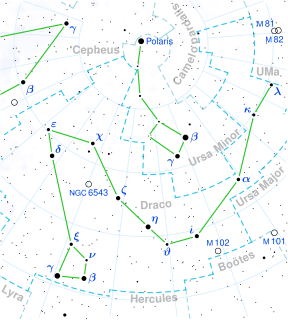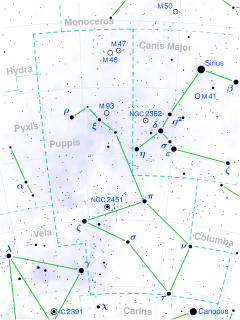Omicron Serpentis is a solitary star in the Serpens Cauda (tail) section of the equatorial constellation Serpens. Based upon an annual parallax shift of 18.83 mas as seen from Earth, it is located around 173 light years from the Sun. The star is visible to the naked eye with a base apparent visual magnitude of +4.26.

Omicron Velorum is a star in the constellation Vela. It is the brightest member of the loose naked eye open cluster IC 2391, also known as the ο Velorum Cluster.
28 Andromedae is a Delta Scuti variable star in the constellation Andromeda. 28 Andromedae is the Flamsteed designation. It also bears the variable star name GN Andromedae. Its apparent magnitude is 5.214, varying by less than 0.1 magnitudes.
15 Arietis is a single variable star in the northern constellation of Aries. 15 Arietis is the Flamsteed designation; it also bears the variable star designation AV Arietis. It has an apparent visual magnitude of 5.74, which is just bright enough to be visible to the naked eye from dark suburban skies. An annual parallax shift of 5.84 mas corresponds to a physical distance of approximately 560 light-years from Earth. At that distance, the star's brightness is reduced by 0.33 in magnitude because of extinction from interstellar gas and dust.
13 Boötis, also known by its variable star designation CF Boötis, is a variable star in the constellation Boötes. It is approximately 550 light-years from Earth, based on its parallax. 13 Boötis is a M-type red giant with a mean apparent magnitude of +5.26. It is classified as an irregular variable star and its brightness varies from magnitude +5.29 to +5.38.

Tau Pegasi, formally named Salm, is a 4.6 magnitude star in the constellation of Pegasus.
Lambda Caeli, Latinized from λ Caeli, is a star in the constellation Caelum. It is also known by its designations HD 30202 and HR 1518. This star is a challenge to view with the naked eye, having an apparent visual magnitude of 6.24. Based on parallax measurements, Lambda Caeli is known to be around 700 light-years distant from the Sun, but is drifting closer with a radial velocity of −4 km/s.
2 Centauri is a single star in the southern constellation of Centaurus, located approximately 183 light years from Earth. It has the Bayer designation g Centauri; 2 Centauri is the Flamsteed designation. This object is visible to the naked eye as faint, red-hued star with an apparent visual magnitude of 4.19. It is moving away from the Earth with a heliocentric radial velocity of +41 km/s. The star is a member of the HD 1614 supercluster.

Omicron2 Centauri is a star in the constellation Centaurus.
HD 29697 is a variable star of BY Draconis type in the constellation Taurus. It has an apparent magnitude around 8 and is approximately 43 ly away.

32 Cygni is the Flamsteed designation for a binary star system in the Cygnus constellation. It is a 4th magnitude star, which can be seen with the naked eye under suitably dark skies. Parallax measurements give an estimated distance of 1,100 light-years (320 parsecs) from the Earth. However, Schröder et al. (2007) suggest the actual value, after correcting for Malmquist bias, may be closer to 1,174 light-years (360 parsecs). Although it is a spectrsocopic binary with components that cannot be separated visually, it has two entries in the Henry Draper Catalogue, with identical magnitudes and positions, but showing the spectral types of the two components.
HD 130144 is a semiregular variable star in the northern constellation of Boötes. The variation in luminosity has an amplitude of 0.38 in magnitude with no apparent periodicity. This is an X-ray source, and was possibly the first M-type giant star to have a magnetic field directly detected. It is considered to be a single star, although there is nearby companion at an angular separation of 0.2023″ along a position angle of 82.2°.

Phi Draconis is a fourth-magnitude variable star in the constellation Draco. It has the Flamsteed designation 43 Draconis. It is also a triple star system where the brightest component is a chemically peculiar Ap star.
Lambda Cygni is a class B5V star in the constellation Cygnus. Its apparent magnitude is 4.54 and it is approximately 770 light years away based on parallax.
Mu Muscae, Latinized from μ Muscae, is a solitary star in the southern constellation of Musca. It is visible to the naked eye as a faint, orange-hued star with an apparent visual magnitude of around 4.75. Based upon an annual parallax shift of 7.21 mas as seen from Earth, it is located about 450 light years from the Sun. The star is drifting further away with a radial velocity of +37 km/s.

QZ Puppis is a class B2.5V star in the constellation Puppis. Its apparent magnitude is 4.49 and it is approximately 650 light years away based on parallax.

NV Puppis, also known as υ1 Puppis, is a class B2V star in the constellation Puppis. Its apparent magnitude is 4.67 and it is approximately 800 light years away based on parallax.

W Cygni is a semi-regular variable star in the constellation Cygnus, located 570 light-years from Earth. It lies less than half a degree southeast of ρ Cygni.

31 Cygni, also known as ο1 Cygni, Omicron1 Cygni, or V695 Cygni, is a star in the constellation Cygnus.
NW Puppis, also known as υ2 Puppis, is a star in the constellation Puppis. Located around 910 light-years distant, it shines with a luminosity approximately 1108 times that of the Sun and has a surface temperature of 15,000 K. Anamarija Stankov ruled this star out as a Beta Cephei variable.






